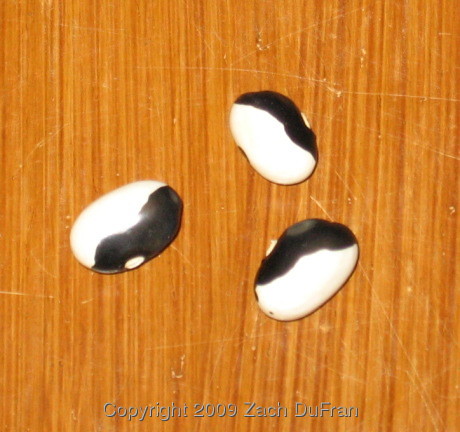My sister works for a non-profit outreach program here in town. On Friday we went to a fund-raising dinner and trivia tournament for her group and my sister's boss (Lynn), who also has a greenhouse, brought me a gift.
These are Ying-Yang beans (Phaseolus vulgaris 'Calypso'). Lynn was given some Ying-Yang beans when she got her greenhouse and she grew them into plants, which flowered and produced about 10 beans. She is now passing three of them on to me for good luck.
They are really cool beans. When she handed them to me I almost felt like I was being invited on a snipe hunt. I thought, "Oh, this must be the mild hazing that all new greenhouse owners endure. Surely these beans were painted by someone." But they're not painted; they are authentically half white and black with little dots even. And as far as I can tell, this is nothing like the fruitless snipe hunts.
These beans grow into small bushes that produce white flowers and eventually some little pods of similarly colored black and white beans that look like ying-yangs. (see here) These beans have also been called "Anasazi beans" since they are believed to have been a crop of the Anasazi native Americans. They can be cooked and eaten much like any other bean. However, as far as I understand, the beans turn solid black when cooked.
I hope to be able to grow some beans of my own and maybe pass them onto to a fellow new greenhouse owner.
 |
| Ying Yang Beans from the Phaseolus vulgaris 'Calypso' plant |
They are really cool beans. When she handed them to me I almost felt like I was being invited on a snipe hunt. I thought, "Oh, this must be the mild hazing that all new greenhouse owners endure. Surely these beans were painted by someone." But they're not painted; they are authentically half white and black with little dots even. And as far as I can tell, this is nothing like the fruitless snipe hunts.
These beans grow into small bushes that produce white flowers and eventually some little pods of similarly colored black and white beans that look like ying-yangs. (see here) These beans have also been called "Anasazi beans" since they are believed to have been a crop of the Anasazi native Americans. They can be cooked and eaten much like any other bean. However, as far as I understand, the beans turn solid black when cooked.
I hope to be able to grow some beans of my own and maybe pass them onto to a fellow new greenhouse owner.
Solid black when cooked? It's interesting!
ReplyDelete[...] The Variegated Thumb » Ying-Yang Beans plants.zachandchristie.com/2009/11/05/ying-yang-beans – view page – cached My sister works for a non-profit outreach program here in town. On Friday we went to a fund-raising dinner and trivia tournament for her group and my sister’s boss (Lynn), who also has a... Read moreMy sister works for a non-profit outreach program here in town. On Friday we went to a fund-raising dinner and trivia tournament for her group and my sister’s boss (Lynn), who also has a greenhouse, brought me a gift. Read less [...]
ReplyDeleteThey truly look so "ying yang" wow.. so cool looking spotted beans.
ReplyDeleteThose are so unique. I can't wait to see the plants. Good luck! :-)
ReplyDelete